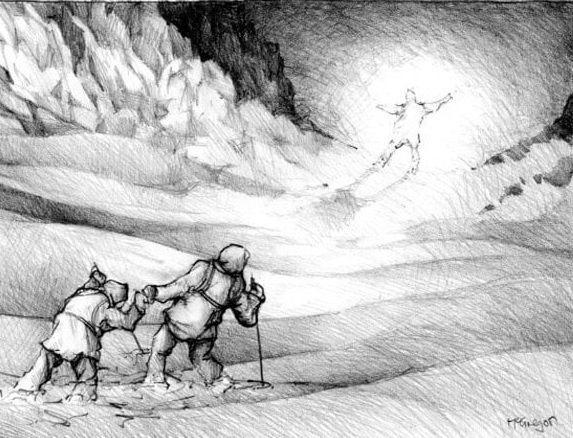Tsuchinoko: Japanese Snake-Like Being
A very realistic looking paper model of a Tsuchinoko by Hajime Emoto
Tsuchinoko are a snake-like cryptid from Japan, said to be about the size of a cat with scaly skin and viper-like fangs.
Description of the Tsuchinoko
A drawing of a Tsuchinoko. Photo: Wikipedia
Tsuchinoko, also known as nozuchi or bachihebi are a snake-like cryptid from Japan.
Tsuchinoko are a type of yokai that have a short, stumpy, snake-like appearance, with a body shape that resembles a hammer or a mallet head without a handle.
They have scaly skin in various earth tones with light-colored bellies, and viper-like fangs carrying a lethal venom. Unlike typical snakes, they have eyelids. These creatures can range in size from thirty to eighty centimeters long and are often compared to beer bottles due to their shape and color.
These creatures can be found throughout Japan and are most active during the day from spring through fall. During the winter, they hibernate in nests that they create in holes along wooded riverbanks. Tsuchinoko are known to make a "chee" sound and snore while sleeping.
When they are young, Tsuchinoko feed on insects, but as they grow, they begin to consume larger prey, such as frogs, mice, and sometimes even cats or dogs. Despite their small size, Tsuchinoko are capable of consuming vast amounts of food. They are also attracted to the smell of miso, dried squid, and burning hair, and have a fondness for sake.
Despite their unusual shape, Tsuchinoko are incredibly agile and can move like an inchworm. Their most well-known behavior is their ability to roll and tumble about. Tsuchinoko are also skilled jumpers, able to jump as far as two to five meters.
They can roll sideways like a log, tumble vertically from tip-to-tail, or even swallow their tail to form a ring and roll like a wheel. In this way they are similar to the American Hoop Snake.
In more whimsical accounts of the Tsuchinoko they are said to possess the gift of speech and a tendency to tell falsehoods. They are also rumored to have a liking for alcoholic beverages.
Origin of the Tsuchinoko
An Artist's impression of the Tsuchinoko. Photo: Happy Serpent
Since prehistoric times, Japanese folklore has included creatures resembling Tsuchinoko. Pottery and stone tools from the Jomon period have been discovered featuring motifs resembling short, stumpy snakes.
During the Edo Period, numerous folkloric encyclopedias documented venomous yokai with rolling, snake-like qualities, such as the nozuchi and tsuchi korobi.
The Kojiki, which is the oldest recorded collection of Japanese legends and tales, includes a reference to the Tsuchinoko.
Reported Sightings of the Tsuchinoko
In the 1970s, Tsuchinoko sightings and reports of live captures garnered national attention, causing a widespread "tsuchinoko boom" and inciting a hunt for these creatures all over Japan.
This craze was further fueled by numerous eyewitness accounts, blurry photographs, and talk show specials, which helped establish Tsuchinoko as a household name.
Since then, Tsuchinoko has continued to be a topic of great interest among cryptozoologists, with monetary rewards sometimes offered to individuals who can provide photographic or physical evidence of their existence.
An annual Tsuchinoko Festival takes place on May 3rd in Higashishirakawa, Gifu prefecture, where the origins of the legend can be traced. The festival involves participants hunting for a tsuchinoko, and a prize of 1,280,000 yen (US$11,449) is awarded to anyone who manages to find one.
In the past, the government of Yoshii, Okayama, offered a 20 million yen (US$200,000) reward for capturing a tsuchinoko.
In June 1994, a man named Kazuaki Noda and his wife claimed to have come across a massive snake with a thick body resembling a beer bottle, and a head that looked like that of a tortoise. Similarly, in May 8th, 2000, a farmer named Sugie Tanaka reported seeing two metallic-colored snakes with "tails like rats."
In June of the same year, a woman named Mitsuko Arima spotted a tsuchinoko swimming in a river.
She recounted her experience, saying, "I was surprised. I just pointed at it and asked ‘Who are you? Who are you?’ It didn’t answer me but just stared. It had a round face and didn’t take its eyes off me. I can still see the eyes now. They were big and round, and it looked like they were floating on the water. I’ve lived over 80 years, but I’d never seen anything like that in my life."
Have you ever seen a Tsuchinoko? Tell us about it in the comments.
If you enjoyed learning about the Tsuchinoko you might be interested in some other reptilian cryptids such as the grootslang or the Hoop Snake.









































